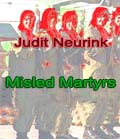A book on Mujahedin-e- khalq; from fighters of resistance movement to "Misled Martyrs".
The writer starts the book by the above mentioned statement where she describes the heart-rending scene of an MEK sympathizer committing self-immolation to protest the arrest of Maryam Rajavi in Paris. The suicide lost her life. The reader now keeps on reading because questions  do not leave his curious mind. What motivation; what kind of hatred makes Neda commit such an act of protest? Why doesn’t Mujahedin khalq Organization prohibit such acts? How come that a Canadian educated woman turns into such a "misled martyr"?
do not leave his curious mind. What motivation; what kind of hatred makes Neda commit such an act of protest? Why doesn’t Mujahedin khalq Organization prohibit such acts? How come that a Canadian educated woman turns into such a "misled martyr"?
There are a few books published on this very topic: Mujahedin Khalq. Ms. Jurith Nourink as an expert on middle East who is correspondent of a famous Dutch newspaper "Trouw", explores MEK’s cult-like attitudes in her book ,"Misled Martyrs".
The author follows the experiences of a defector of MEK named "Yaser Ezzati", describing his bitter life, she goes over the forty-year history of Mujahedin as an armed organization that blends its revolutionary version of Shiites with parts of Marxism ideology such as classless society. Ms. Nourink believes that the organization has gradually turned into a cult since Massoud and Maryam Rajavi got married. The influential leader of the cult, Massoud Rajavi seeks absolute power which, according to British historian Dalberg Acton, is the origin of absolute corruption. Any mean to achieve power, finds a saint nature which justifies MEK’s collaboration with the enemy of Iran’s national interests and territory, Saddam Hussein, and suppression of Kurdish uprising against Saddam during the Gulf War 1991. The quotes made by former members of MEK, confirms the fact that members of the cult obey Massoud Rajavi so blindly and worship him as an idol. Haydiger says:"asking question is the sign of piety of thought" but in MEK, questioning and criticizing are considered as taboos.
Nourink explains that thinking and asking is exclusive concession for a few high ranking members of the organization. Following the ideological revolution in the organization, the members were forced to divorce their spouses and then they were unwillingly separated from their children since Rajavi does not tolerate any obstacle between himself and his devotees. The only central idea and joining point in the group is their animosity towards Iranian regime and their sense of revenge.
The book describes the feeling of those who once thought they were fighting for the benefit of a free cultivated Iran but when they faced the cult-like tendencies of the organization, its close relations with Saddam Hussein and torture and imprisonment in the camps, they felt suppressed and disappointed so they left the group. Nourink portrays the grieves and pains of their suffering sole. These misled individuals thought that criticizing their leader signifies their disloyalty toward "saint ideals" of the organization, although they were quarrelling with their conscience and knew that their part was fake or destructive, they kept silent for years. They paid a high price for those years of being manipulated, isolated, extremist and depressed slaves of Rajavi.
A defector of the cult says:" they injected hatred and rancor in our sole all the time. We were not able to make a decision." Another defector sees himself so misled that calls "Eternal Light" operation as "Eternal Lie". The organization might have been damaged mostly by the side of these very people rather than Islamic Republic.
The author of the book refers to various books on psychological pathology and the origins of the cults. She finds all fundamental elements of a cult in MKO. Rajavi had all the time been studying psychological books in order to spread his absolute rule on the members’ minds, according to one of her sources. If Rajavi did not succeed to master a member’s mind, then he/she would be labeled as the regime’s spy who would consequently go under threat, torture, pressure and imprisonment.
Nourink uses her artistic talent to develop the characters of her book, describing their true emotions so tactfully, although she is not always neutral as a journalist should be.
Sometimes she looks like a human rights activist but sometimes she doesn’t offer a persuasive analysis. For instance, she believes that in 1991 when Saddam was threatened by Kurdish uprisings, MKO guaranteed his survival otherwise he would have fallen on the same year.
Nourink assumes the memoirs and experiences of defectors as historical facts, she is not able to take an impartial position of a journalist. She does not enter the organization to talk with MKO’s central committee and its present loyal members so that her sources would not be restricted to a few defectors.
Nourink might have authored one of the most comprehensive books on MKO, after Irvand Abrahamian’s book " The Iranian Mojahedin ". At the end of the book she wonders why American neo-cons who are aware of MKO’s hostility towards America and know that MKO assassinated several American military forces and citizens at Shah’s era and had a supportive part in hostage taking of American embassy in Tehran and also it is labeled as a Foreign Terrorist Organization by DOS, do not try to remove the group from Iraqi territory. Why do they still view MKO as an option to pressure or to overthrow the Iranian regime? Can really such a terrorist cultist organization be the messenger of democracy or the defendant of human rights in Iran?
By: Payam Rahaee , Translated by Nejat Society

